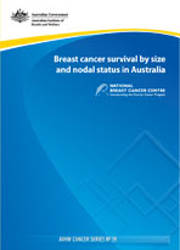Summary
Background
This report by the Australian Institute of Health and Welfare (AIHW) and the National Breast Cancer Centre (NBCC) provides descriptive statistics of relative survival to 2006 in Australian women diagnosed with invasive breast cancer in 1997. In addition, the data quantify the associations of size and nodal status with survival in Australia, both in general and by age at diagnosis, place of residence and socioeconomic status.
This report is a follow-up of Breast cancer size and nodal status (AIHW & NBCC 2001). Data consisted of 10,017 cases of women diagnosed with breast cancer in 1997; of these cases, there were 3,323 deaths up to 31 December 2006.
Key findings
- Survival was considerably higher for women with smaller tumours compared with women diagnosed with larger tumours. Specifically, 5-year relative survival was 98% for women with cancers 10 mm in size or less and declined to 73% for women with cancers 30 mm or more and to 49% for women with unknown tumour size.
- Similarly, survival was significantly higher in women whose lymph nodes were cancer-free (negative nodal status) compared with women whose cancer had spread to their lymph nodes (positive nodal status). Specifically, 5-year relative survival was 97% when nodes were negative, 80% when nodes were positive and 71% when nodal status was unknown.
- Women with unknown tumour size and nodal status had the lowest relative survival throughout the analyses. Survival in these women may be poor because of advanced co-morbidity, frailty for reasons of age or other factors where a comprehensive investigation and treatment of their cancers was not deemed to be warranted.
- Age effects were analysed, with poorer survival in women aged less than 40 years and aged 70 years and over.
- Survival was also highest among women living in major city areas and in areas with highest socioeconomic status.
- Some groups of women showed a relative survival greater than 100%. Although these figures are based on small numbers, they may validly occur in women with successful early diagnosis and treatment to reduce the risk of dying below the risk of women in the general community.



